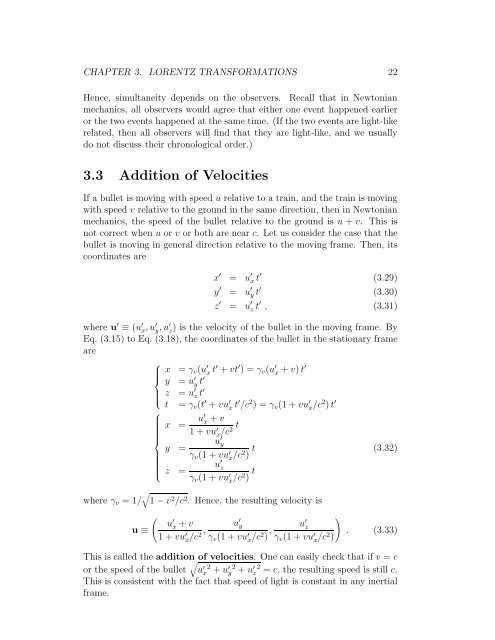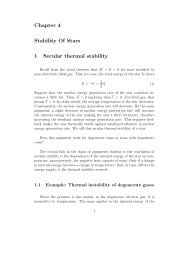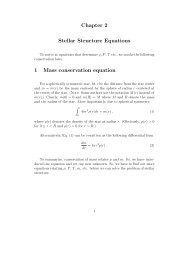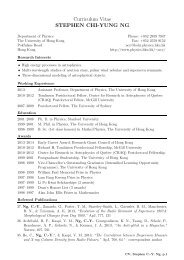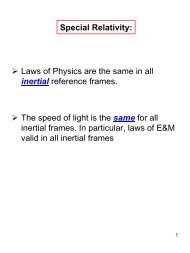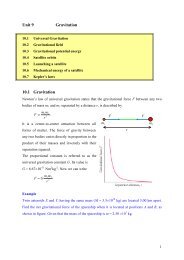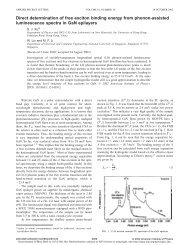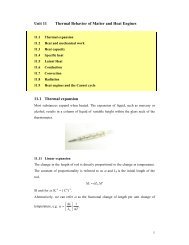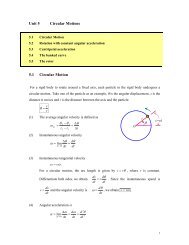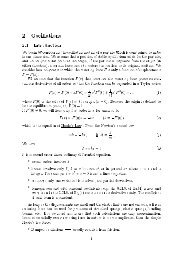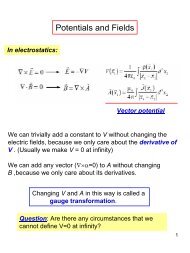here - Department of Physics, HKU
here - Department of Physics, HKU
here - Department of Physics, HKU
Create successful ePaper yourself
Turn your PDF publications into a flip-book with our unique Google optimized e-Paper software.
CHAPTER 3. LORENTZ TRANSFORMATIONS 22<br />
Hence, simultaneity depends on the observers. Recall that in Newtonian<br />
mechanics, all observers would agree that either one event happened earlier<br />
or the two events happened at the same time. (If the two events are light-like<br />
related, then all observers will find that they are light-like, and we usually<br />
do not discuss their chronological order.)<br />
3.3 Addition <strong>of</strong> Velocities<br />
If a bullet is moving with speed u relative to a train, and the train is moving<br />
with speed v relative to the ground in the same direction, then in Newtonian<br />
mechanics, the speed <strong>of</strong> the bullet relative to the ground is u + v. This is<br />
not correct when u or v or both are near c. Let us consider the case that the<br />
bullet is moving in general direction relative to the moving frame. Then, its<br />
coordinates are<br />
x ′ = u ′ x t′ (3.29)<br />
y ′ = u ′ y t ′ (3.30)<br />
z ′ = u ′ z t′ , (3.31)<br />
w<strong>here</strong> u ′ ≡ (u ′ x , u′ y , u′ z ) is the velocity <strong>of</strong> the bullet in the moving frame. By<br />
Eq. (3.15) to Eq. (3.18), the coordinates <strong>of</strong> the bullet in the stationary frame<br />
are<br />
⎧<br />
x = γ v (u ′ x ⎪⎨<br />
t′ + vt ′ ) = γ v (u ′ x + v) t′<br />
y = u ′ y t′<br />
z = u<br />
⎪⎩<br />
′ z t′<br />
t = γ v (t ′ + vu ′ x t ′ /c 2 ) = γ v (1 + vu ′ x/c 2 ) t ′<br />
⎧<br />
x =<br />
u′ x + v<br />
1 + vu<br />
⎪⎨<br />
′ x/c t 2<br />
u ′ y<br />
y =<br />
γ v (1 + vu ′ x /c2 ) t<br />
(3.32)<br />
u ′ z<br />
⎪⎩ z =<br />
γ v (1 + vu ′ x/c 2 ) t<br />
√<br />
w<strong>here</strong> γ v = 1/ 1 − v 2 /c 2 . Hence, the resulting velocity is<br />
u ≡<br />
( u<br />
′<br />
x + v u ′ y<br />
1 + vu ′ x /c2, γ v (1 + vu ′ x /c2 ) , u ′ )<br />
z<br />
γ v (1 + vu ′ x /c2 )<br />
. (3.33)<br />
This is called the addition <strong>of</strong> velocities. One can easily check that if v = c<br />
or the speed <strong>of</strong> the bullet √ u ′ x 2 + u ′ y 2 + u ′ z 2 = c, the resulting speed is still c.<br />
This is consistent with the fact that speed <strong>of</strong> light is constant in any inertial<br />
frame.


